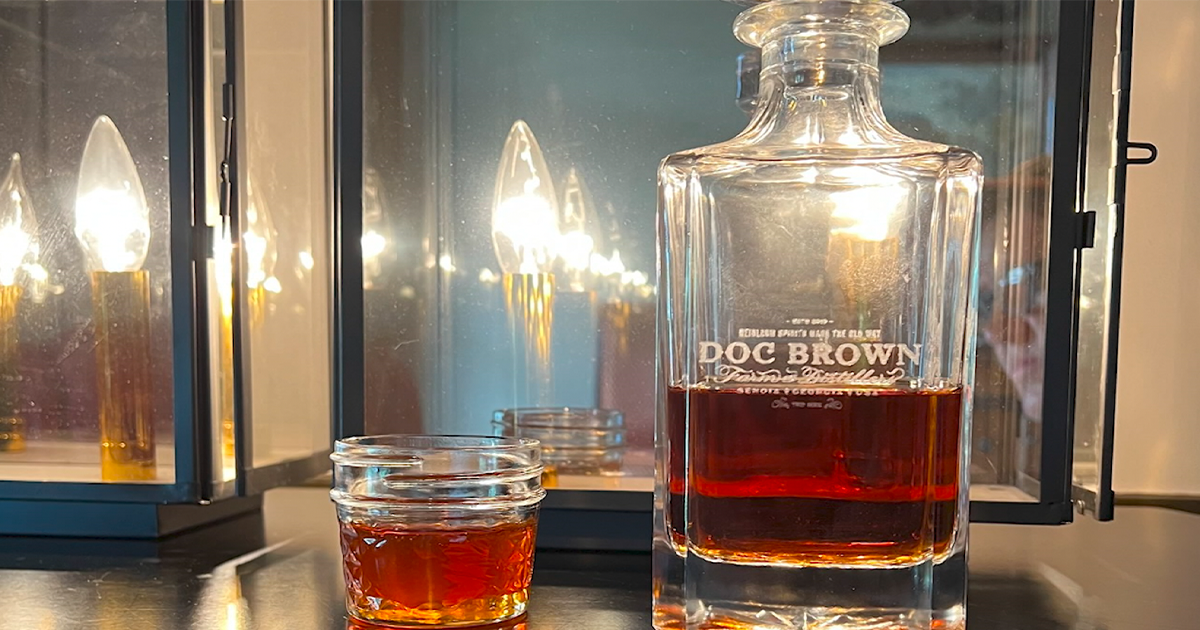Senoia, GA
As we all know, there is no “I” in team, but there are multiple “I’s” in Doc Brown Farm & Distillers, and teamwork is what this organization is most proud of.
“We’re all different. We have similarities, but we have differences and we all bring something different to the table,” says Paige Dockweiler, Co-Founder of Doc Brown Farm & Distillers.
Paige Dockweiler, the “Doc” in Doc Brown was born in Cordele and raised on a farm – Paige’s father was a successful soybean, watermelon, cotton and corn producer. Paige however pursued a different path. When she’s not making spirits, Paige is focused on lifting the spirits of others as a Registered Nurse and Specialist in oncology and hematology.
“I tell people, and we’ve trademarked the phrase high heels and cornfields because we’ve basically traded our high heels and suits in for cornfields and boots,” says Amy Brown, the other Co-Founder of Doc Brown Farm & Distillers.
Amy Brown spent 32 years in the corporate world, and like Paige, she too has deep ties to agriculture having grown up on a small farm in Hog Mountain. Lastly, there’s Amy’s son, Dan. A full-time pilot for UPS who admits, flying isn’t his only passion.
“Yeah, you know what’s funny is a lot of, a lot of pilots, are farmers also,” says Dan. “So a lot of times the guy I’m flying with owns land or grew up on a farm. And so we can relate to each other, about what each of us do on our off time. Then when I am up there flying, I make my to-do list of things I need to do when I get back home.
Yes, Dan, Amy, and Paige each have a lot on their plates, but it hasn’t stopped them from pursuing that one common goal of making quality spirits the old way. Using heirloom grains grown directly on their farm. The grain of choice: Jimmy red corn.
“It’s a red variety of corn that grows, um, of course, as you can see, deep red burgundy and we harvested it,” says Amy. “We took it to the grist mill, had it ground into a specific type of grit type substance. Um, but the grits have to be a little bit more, uh, grainy for the mash. This year we added a white called Hastings prolific and then, uh, also a blue corn called a blue Claridge. But we all come from families that love the land.”
“For us, with our end product being bourbon and growing these rare heirloom corns that many people have forgotten about,” says Paige. “Bringing back the heritage and the legacy of the Indian culture and this Indian corn that they used to eat. And of course it is edible in some ways, but we use it to distill. And for me, I have a lot of pride in knowing that we’re growing this heirloom corn as clean as we can. We’re distilling it. It’s as clean as it can be distilled. And using the waters that we have up in North Georgia.”
“Never in a million years did I think I would be a farmer or add onto that, a bourbon maker,” says Amy. “And I call myself a bourbon farmer. And that’s usually the phrase that catches people’s attention because you can be a corn farmer, a soybean farmer, watermelon farmer, but when you say you’re a bourbon farmer, that brings a lot of interest, because they’re like, ‘I didn’t know bourbon grew out on the land,’ and that’s where you get to tell your story of the love of the earth and the love of the land and the end product.”
Like any good farmer will tell you, be it a traditional farmer or in Amy’s case, a bourbon farmer, achieving that end product is not a race. In fact it’s more like a marathon, but oh, once you cross that finish line, the feeling is one of relief, joy, and euphoria. Then again, that might be the bourbon talking.
“You know, when you’ve, when you harvest the corn and you grind it and you distill it and you put it in the barrel, then you have to wait and you’re like, ‘Oh man, I hope it’s good,’ you know, and then when you get a glass of it out and it’s actually good, it’s really a great moment, because you created that and it’s a really cool thing to be able to taste the flavors of the corn and the grains together,” says Dan.
“You have to have two things to have good bourbon; actually three things,” says Amy. “You’ve gotta have good grain, you gotta have good water, and you gotta have good barrels. And we’re fortunate that in the state of Georgia, we are able to gather all three of those components together. We have fabulous corn. We use the foothills of the Blue Ridge Mountain limestone filtered water out of a deep, deep well. And then believe it or not, our barrels are made here in Georgia as well at a place called the Gainesville Cooperage. It’s the only cooperage in the state of Georgia. So, everything we do is Georgia grown from our corn, to the water, to even our barrels. We don’t even get our barrels outside of the state.”
By: Ray D’Alessio

